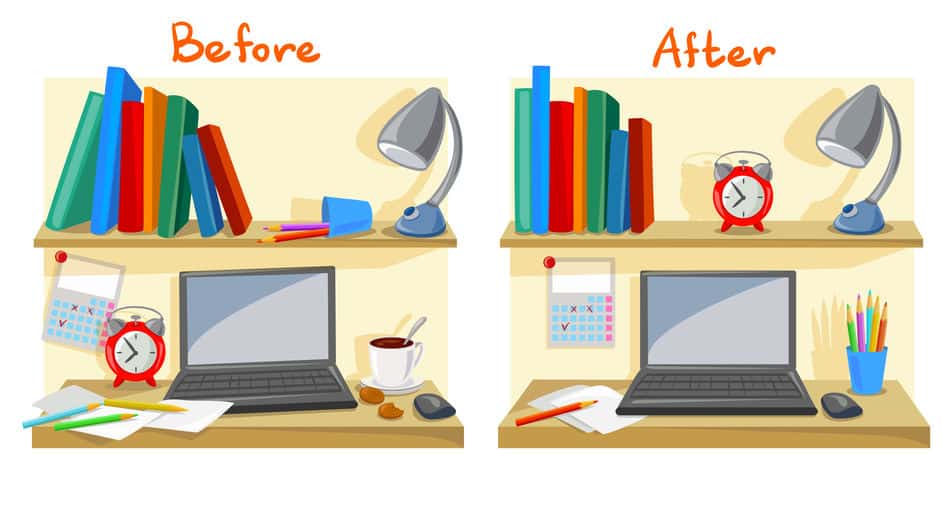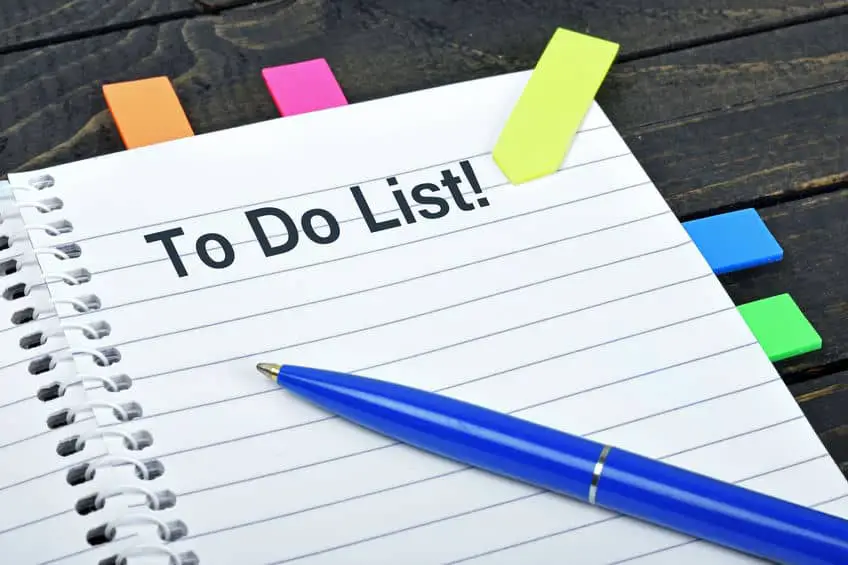Many types of jobs have peaks and valleys where you are required to drive hard to meet deadlines while at other periods you may have extra free time on your hands. In some situations you may be overqualified for the job or generally don’t have enough work to do. Regardless, you need to know how to make use of your time wisely.
What do you do when you’re at work with nothing to do? If you are at work with nothing to do, it’s best to stay active and sharpen your skills. Here are some possible tasks you could accomplish:
- Check your emails
- Unsubscribe from newsletters
- Email your boss
- Declutter your desk
- Organize your files
- Make a to-do list
- Find a new skill
- Find a conference or webinar
- Check in with coworkers
- Go for a walk
- Redecorate your space
By doing all eleven of these activities, you can help improve you reduce your stress, help boost office morale, better your resume, and overall develop your time management skills. So, read on to find out more about these eleven tips for what to do at work when you have nothing to do!
What to Do at Work when You Have Nothing to Do?

Check Your Emails
Don’t lie. You know you have at least 2,094 unread emails cluttering up your inbox. Now is the time to finally go through all of them and organize your inbox. One study written in the jouranls.aom.org by William J. Becker, Liuba Belkin, and Sarah Tuskey showed that having to check your work emails outside of your office hours may negatively impact your mood, health, and relationship with your partner.
More than merely marking each one as “read,” do your future self a favor and create folders within your email desktop to keep everything in the place it should be. By organizing your inbox into smaller and more manageable chunks, you won’t feel as overwhelmed by the tasks at hand.
There is not a specific number of folders or even subfolders that you need to create to feel the positive impact of the organization; instead, you should organize your email folders into what will work best for you.
When you are creating these email folders, keep in mind that the goal is upkeeping. Try not to burden yourself with too many subfolders or extra ones that will be useless to you. For example, if you work somewhere that receives many newsletters, consider having one folder titled “Newsletters,” rather than six subfolders for each type of newsletter you receive.
If you are genuinely committed to being ruthless with your inbox, try Fast Company’s five folder system:
- Inbox – Emails do not live there for more than 24 hours
- Today – Anything that needs attention that day
- This Week – Anything that has until the end of the workweek for a response
- This Month/Quarter – Longer-term problems or responses
- FYI – Anything dealing with marketing information or general newsletters/information
Unsubscribe from Newsletters
While we are on the topic of organizing your email inbox, this is a great time to unsubscribe from all those pesky newsletters and targeted advertisements. Maybe the idea of getting a coupon for a fancy new printer with laser speed 3D printing sounded worth it ten months ago, but the daily reminder emails that clutter your inbox are not!
Depending on the email software your company uses, there are shortcut methods to unsubscribing from newsletters and advertisements.
If you use Gmail:
- Open Gmail in your preferred browser.
- Underneath the company’s name, there will be a button that says, “Unsubscribe” or “Change Preferences.”
- If that button isn’t there, you can block the sender by pressing the three vertical buttons on the far right and selecting “Block.”
If you use Outlook:
- Select the sender’s name or message you want to block.
- On the toolbar (top of the screen), there is a “Junk” option.
- From there, click on “Block” or “Mark as Spam.”
- Note: this will not unsubscribe you from their messages, but it will automatically put all future emails from this sender into the spam folder.
By doing something as simple as this, you will find that your inbox folder becomes less messy and daunting to go through. Along with that, it will reduce the total amount of time you spend looking at your emails significantly.
Pew Research Center has found that the more emails you receive daily, the more spam emails you receive. With nothing else to do at work, relieving your inbox of useless newsletters and annoying spam emails will leave you feeling accomplished and fresh.
Email Your Boss
Since your email is already opened, you may as well email your boss. It may sound strange because you would think the last thing your boss wants to know is that you are sitting at work bored. However, this is an excellent opportunity to prove to your leadership team that you are willing and capable to take on a heavier workload. This can get you one step closer to that promotion or even a pay raise!
However, do not tell your boss that you are bored! At least not exactly. There is a delicate way of explaining to your supervisor that your lack of responsibility is negatively impacting your relationship with the company. Business Insider reveals a few prep conversations you should have with yourself before clicking send.
Before setting up a meeting with your boss, ask yourself the following:
- What is my end goal?
- Are you going for a raise? More responsibilities? New skills?
- How will I achieve this goal?
- Business Insider’s advice is always to approach your boss with at least two solutions. This will keep the conversation from sounding like an ultimatum.
- Is this a long-term or short-term fix?
- This should be a stepping stone for future changes, not a quick solution.
Once you have a real understanding of what you are looking to gain from the conversation, it is time to send the email. Be sure to stay honest and respectful, as well as realistic. You may be at work with nothing to do now, but the last thing you would want to happen is for too many responsibilities to be placed on your shoulders.
Declutter Your Desk

Whether you work remotely or in a formal office, it is still a good practice to get your desk in order. The Princeton Neuroscience Institute found that there is a direct correlation between having a cluttered environment and the level of productivity and stress an individual feels.
Being surrounded by stacks of papers and sticky notes galore may not be good for your stress level or how much you can get done in a day. So, to help your workday tomorrow (and the days after) go smoothly, take the time you have now and declutter your desk.
If it seems an overwhelming process, start by breaking your desk and workspace down into smaller sections. The same Princeton Neuroscience Institute study found that the best solution towards overwhelming clutter is a “…top-down, goal-directed mechanisms such as attention, and by bottom-up, stimulus-driven mechanisms.” In other words, you want to create smaller, more attainable goals that will eventually accomplish your larger goal at hand (decluttering your desk), while also rightfully rewarding yourself.
One system to try out is setting a timer for fifteen minutes of straightening up, followed by a five-minute social media reward or snack break. The main goal is to allow the reward level to match the work level. For example, you should not give yourself a half-hour break for moving two folders into a binder. It may take some serious self-discipline, depending on the level of mess.
If you are still struggling to declutter your desk, you can try the famous “KonMari” method where if an item doesn’t “spark joy,” you throw it out or donate it. If you are a bit more on the extreme side, you can throw out everything that isn’t important and start completely fresh. No matter which method you choose, you just need to start! Little by little, you will see your desk begin to declutter.
Organize Your Files
If you are already up for the task of decluttering your desk, now is the time to organize all your files. Chances are there are lots of useless documents and expired receipts and projects that are taking up valuable space in your desk drawers. If you are at work with nothing to do, this is an excellent opportunity to sit with yourself (or coworkers) and go through large filing cabinets.
One method that may work for you is to dump everything out on the floor to go through each paper, one by one. The main benefit of organizing with this method is that you will be forced to go through everything and decide if it is necessary to keep. If it is, consider placing it within smaller files that will further organize everything when it is time to put it all away.
Just like with organizing your email inbox, you want to create a system that will be most efficient for you and your daily needs.
Digital Files
The organizing of your files shouldn’t stop in the physical office! In the modern age, most records and backups end up on your computer. This digital data can quickly become a convoluted mess and should be given the time necessary to organize it all. For organizing your digital space, follow the tips below.
Start with your “Downloads” folder
Take everything out of your downloads folder that you need and put them in their intended locations. Pictures should be moved to your “Pictures” folder; documents should be moved to their proper folders. Be diligent during this process and only take what is needed. Once everything you need is out of your “Downloads” folder, delete everything else!
Go to your “Documents” folder
In your documents folder, make subfolders for the different types of documents that you have. For example, if you write often and have templates, keep a folder named, “Writing Templates” as the only place you store templates from now on. If anything does not have a category for a subfolder or is unnecessary, delete it!
Finish with your Desktop
Once the two main clutter areas are organized, it is time for the grand finale: your desktop. If you are at work with nothing to do, chances are you’re staring at your desktop anyway! Customize your toolbar with the apps you use daily.
From there, place any free-floating documents and files in their correct locations (i.e., Documents > Writing Templates). If a file can go in a folder, put it in that folder and take it off your desktop! Any essential files that do not have a specific location should go into a folder labeled “ETC.”
Make a To-Do List

If you are at work with nothing to do, make a to-do list! Writing things down activates more parts of our brain; therefore, we are more likely to remember what we are writing, as explained by “Research Matters/The Magic of Writing Stuff Down.” Trying to keep all the tasks of the day tucked away into our brains can cause extra stress and cause you to forget things! Avoid forgetting an essential task by creating a to-do list.
When it comes to creating the actual to-do list, the first factor you should consider is: how would you like to organize your to-do list? It is easy to throw all your daily tasks onto one master list, but this might be counterproductive as it may overwhelm you to see so many things that need to get done. Instead, consider having two separate to-do lists. One can be for your personal daily tasks, and the other can be for your job-related daily tasks.
As you are creating your to-do list, try to list the items by importance or time sensitivity. For example, if you must reply to your boss’s email by the end of the day, that should be higher on the list than taking out your desk trash. By keeping the to-do list in order of importance, you are more likely to accomplish tasks and feel better doing so.
This comes from the Zeigarnik effect, as explained in this article. The Zeigarnik effect means people remember negative experiences and feelings longer than positive ones. So, you don’t want to feel the burden of incredibly important tasks weighing down your day simply because you listed them further down than they should be.
Tips for Creating a To-Do List
Some quick tips for when you are creating your to-do list (personal or otherwise) are the following:
- Be concise – Don’t overflow your list with too much description.
- Give Time Constraints – If you are a notorious procrastinator, give yourself specific time restraints to complete a task.
- Be realistic – Remember, there are only eight hours in the workday!
- Don’t forget the fun stuff – There’s no shame in putting fun things you want to do on the list, as well.
Find a New Skill
On one of those to-do lists, you should add “find a new skill.” Not only is it always good to have a resume booster, but learning a new skill is a great way to pass the time when you are at work with nothing else to do. In the golden age of the internet, all the knowledge of the world is only a click or YouTube video away!
Of course, if you are going to try and learn a new skill at work, you should probably try to keep the skill related to your career. You might be excited to learn how to juggle, but your company may not be!
Some skills and information may take longer to master than others, but your time certainly won’t be wasted knowing you learned something new today.
Find a Conference
Another way to learn a skill and kill time is by attending a conference! Conferences are a great way to network and share ideas with peers and potential clients. Although you cannot go to one right this second, it is a good idea to see if any are going on in your area or the future.
One resource you can use to find this information is your boss. Chances are, they attend an array of conferences, whether they pay or are invited. Be courageous and ask your supervisor if any conferences are coming up that you could attend.
If that seems too intimidating, another resource you can use to find conferences while bored at work is Google events. The free calendar usually lists all kinds of events going on in your area; you can simply search “conference” and your location to narrow your search.
You may also want to check any bulletin boards around the office and backlog of emails. Usually, if there is a convention pertaining to the company, someone in your HR or PR department will send out a notice.
However, not every conference has to be in person. Consider signing up to be part of a webinar! If you have not heard about them yet, a webinar is essentially like a zoom call (or phone call, depending on the type) where like-minded people exchange ideas and learn a new skill.
Some great resources to find conferences and webinars are:
- Go To Meeting
- All-Conference
- Google Events
- Local colleges
- Company Newsletters
Whether they are online or in-person, conferences are a great way to network and develop yourself as an employee. If you do not want to attend one on your own, consider inviting a coworker to tag along to the event.
Check in on Your Coworkers
Speaking of coworkers, it might be a good idea to use your free time to check in on them. A study done by Harvard Business Review found that checking in with your coworkers builds a greater sense of belonging and feeling of community. Simply asking, “How are you doing, and how can I help?” seemed to raise office morale and gave 39% of respondents, “…the greatest sense of belonging.”
If someone isn’t having the best of days, it will serve you well to try to help them as much as possible. By going out of your way to be kind and help your coworkers, you will find yourself less stressed, emotionally well, and happy. Plus, you will be managing your time more wisely helping someone three doors down than taking another Buzzfeed quiz to find out what type of bread you are!
Go for a Walk

While you are already away from your desk helping coworkers, keep the momentum going by taking a walk. In the age of sedentary living, the average American sits for ten hours a day (Get America Standing)!
Most health professionals suggest adults get around an hour of exercise each day, which can be difficult for anyone that works a desk job. To help with this struggle to find time for excercise, take a half an hour walk every day from your office.
This doesn’t have to be a full 30 minutes all at once! “Fit in Walking: Morning, Noon or Night” gives advice to help fit 30 minutes of walking in even the busiest schedule.
To fit thirty minutes of walking into every day, it is recommended to:
- Park further from the door – As long as it is safe to do so, park about ten minutes from the employee entrance in the morning.
- If the parking lot isn’t large enough, you can park five minutes away from the door to total the ten minutes of walking commute.
- Walk for ten minutes at lunch – Even if you are walking in circles, the goal is to get up and move for ten minutes during your lunch break.
- Try to visit a healthy eatery near your job where you can easily walk to!
- Take time after you clock out – Once you clock out and go home, try to walk around your neighborhood or house for at least ten more minutes.
Once it becomes a routine, it will be easier every day to stick with the new walking pattern!
Redecorate Your Office Space
Whether you are working from home, in a cubicle, or using one of those treadmill desks, redecorating your office space can help you feel less anxiety and more at home. According to Design by Color, here are some elements of redesign you should try to include.
- Nature-Based Items – Although “stainless steel modernism” is trending, a more natural base to your items (such as wood, bamboo, leather, etc.) can lead to a calmer mind.
- Personal Items – Make your space truly your own by adding personal items! It seems obvious but bringing items from home into your office will help you feel more secure in the space.
- Plants – You can never have too much greenery in your office space, especially if you are working from a windowless cubicle! Plants are a great way to reconnect with nature and give you an outlet for caring for something other than yourself. If you’re worried about sunlight, succulent plants do very well, even with little sun and little watering.
In Conclusion
In conclusion, being bored at work with nothing to do can be mind-numbingly torturous. You know you are there to get a job done, but maybe the days’ work just isn’t enough for you. And that’s not a bad thing! It only gets bad when the hours start to feel like hours.
To keep your mind interested in your job and the rest of your day, following these eleven tips will help guide you throughout the lull of business. So, instead of sitting around waiting for the next task, try clearing out your emails, communicating with your boss, checking in with coworkers, organizing all your files, going for a walk, learning something new, or maybe consider finding a new job. (We won’t tell!)
